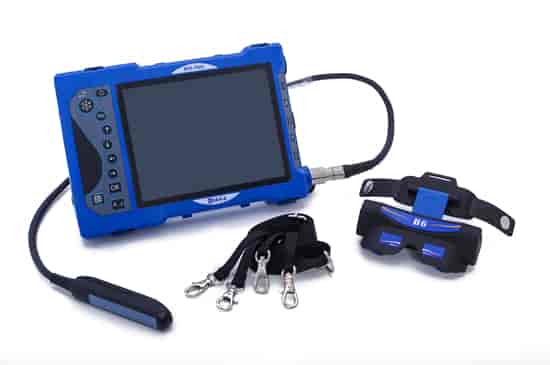A Veterinary ultrasound machine is a vital tool used for diagnosing and monitoring various health conditions in animals. From pregnancy detection to identifying internal injuries and organ issues, ultrasound technology is integral to modern veterinary practices. However, if you're considering purchasing a vet ultrasound machine, understanding the costs involved is crucial. This article explores the various factors that affect the cost of a vet ultrasound machine and provides insights into the different price ranges and what to expect in terms of features and quality.

1. What Affects the Cost of a Vet Ultrasound Machine?
The price of a veterinary ultrasound machine can vary widely, depending on several factors, including the machine's features, brand, and intended use. Here are the key factors that influence the cost:
a. Type of Ultrasound Machine
There are various types of ultrasound machines, each designed for specific applications and animals:
portable ultrasound Machines: These machines are lightweight and ideal for use in the field or for mobile veterinary services. They are generally less expensive than full-sized systems, with prices typically ranging from $1,000 to $10,000, depending on features and brand.
Cart-based Ultrasound Machines: These are more advanced and are commonly used in veterinary clinics. They offer higher image quality and more advanced features but are also more expensive. Prices for cart-based machines can range from $10,000 to $50,000.
Handheld Ultrasound Devices: Compact and easy to carry, these are the most affordable options, with prices starting at around $500. They are best suited for basic applications, such as pregnancy checks in small animals or livestock.
b. Imaging Quality and Technology
The imaging capabilities of a veterinary ultrasound machine significantly impact its cost. Machines with higher resolution, advanced imaging modes, and more sophisticated technology will be priced higher. Some key features that affect cost include:
2D vs. 3D/4D Imaging: Basic 2D ultrasound machines are typically more affordable, while machines capable of 3D or 4D imaging (offering real-time, moving images) tend to be more expensive.
Doppler Ultrasound: Machines with Doppler capabilities, which can visualize blood flow, are more advanced and, therefore, costlier. Doppler ultrasound is especially useful for assessing heart function and vascular health in animals.
High-Frequency Probes: Machines that offer multiple probes or high-frequency probes for detailed imaging of smaller animals or specific body parts will increase the overall price.
c. Brand and Manufacturer
Well-known brands that specialize in veterinary ultrasound machines often have higher price points due to their reputation for quality, durability, and after-sales service. Some of the top manufacturers of vet ultrasound machines include:
BXL(博祥来)
While branded machines might come at a premium, they often offer better performance, longer warranties, and more reliable customer support. However, smaller or newer brands might provide more budget-friendly options.
d. Advanced Features and Software
Many modern vet ultrasound machines come with advanced features that enhance diagnostic accuracy, but these features also add to the cost. Some common advanced features include:
Touchscreen Interface: Machines with touchscreen controls are typically more user-friendly and efficient but tend to be more expensive.
Multiple Probes: Machines that come with several probes for different diagnostic purposes will generally cost more.
Data Storage and Connectivity: Devices with built-in storage, Wi-Fi connectivity, and compatibility with cloud systems or external devices for easy data transfer will be priced higher.
Imaging Software: High-end machines often come with proprietary imaging software that provides enhanced diagnostic tools and report generation, which can further increase the price.
2. Cost Breakdown of Different Vet Ultrasound Machines
To help you better understand what to expect when shopping for a vet ultrasound machine, here’s a breakdown of different types and their approximate price ranges:
a. Entry-Level handheld ultrasound machines
Cost Range: $500 to $3,000
Best for: Small animal practices, mobile vets, or breeders performing basic pregnancy checks.
Features: Basic imaging, often limited to 2D. Suitable for simple diagnostic purposes but lacks advanced features like Doppler or 3D imaging.
b. Portable Ultrasound Machines
Cost Range: $1,000 to $10,000
Best for: General veterinary practices, breeders, and livestock managers.
Features: Portable with better imaging quality than handheld devices. These machines often include various probes and may have Doppler capabilities for more advanced diagnostics.
c. Mid-Range Cart-based Ultrasound Machines
Cost Range: $10,000 to $25,000
Best for: Veterinary clinics and hospitals requiring higher imaging resolution and a broader range of diagnostic capabilities.
Features: Excellent imaging quality with Doppler and 3D capabilities. Often come with multiple probes and advanced software for detailed diagnostic analysis.
d. High-End Ultrasound Machines
Cost Range: $25,000 to $50,000+
Best for: Specialized veterinary hospitals and practices with a high volume of patients, requiring advanced diagnostic tools.
Features: These machines provide top-tier imaging quality, including 3D/4D imaging, multiple probes, Doppler functionality, and sophisticated imaging software. They are ideal for comprehensive diagnostics in complex cases.
3. Additional Costs to Consider
In addition to the initial purchase price of a veterinary ultrasound machine, there are other costs to consider that can impact your budget:
a. Probes
Different types of probes are used for specific applications, such as abdominal, cardiac, or musculoskeletal imaging. Probes may need to be purchased separately, and the price for individual probes can range from $1,000 to $5,000, depending on the type and brand.
b. Maintenance and Warranty
Regular maintenance is crucial to ensure that the ultrasound machine operates efficiently and lasts for many years. Service contracts or extended warranties typically add to the overall cost. It's important to budget for ongoing maintenance, repairs, and software updates.
c. Training and Support
Many ultrasound manufacturers offer training packages for vets and staff to help them get the most out of the machine. While some manufacturers provide free training, others may charge for in-depth training sessions, which could increase the total cost.
4. Should You Buy New or Used?
If your budget is limited, buying a used vet ultrasound machine might be a viable option. Used machines are often sold at significantly lower prices, typically ranging from 30% to 50% of the original cost. However, it’s important to ensure that the used machine is in good condition and comes with some warranty or service contract to cover potential repairs.
Pros of Buying Used:
Lower upfront cost.
Opportunity to purchase a high-end machine at a reduced price.
Cons of Buying Used:
May come with limited or no warranty.
Potential for outdated technology or missing advanced features.
Risk of higher maintenance or repair costs over time.
Conclusion
The cost of a vet ultrasound machine can vary greatly depending on the type, features, and brand. Prices typically range from $500 for entry-level handheld devices to $50,000 or more for high-end, feature-rich machines used in specialized veterinary practices. It’s essential to consider not only the purchase price but also additional costs such as probes, maintenance, and training when determining your budget. Whether you choose a new or used machine, the right ultrasound system can be a valuable investment that enhances diagnostic capabilities and improves patient care in your veterinary practice.







